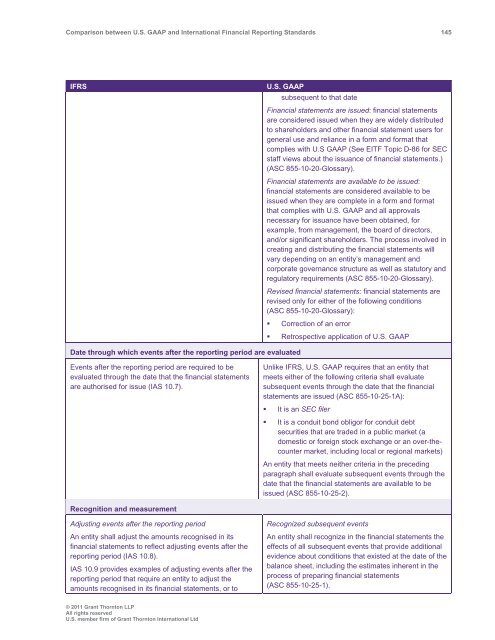Comparison between U.S. GAAP and International ... - Grant Thornton
Comparison between U.S. GAAP and International ... - Grant Thornton
Comparison between U.S. GAAP and International ... - Grant Thornton
Create successful ePaper yourself
Turn your PDF publications into a flip-book with our unique Google optimized e-Paper software.
<strong>Comparison</strong> <strong>between</strong> U.S. <strong>GAAP</strong> <strong>and</strong> <strong>International</strong> Financial Reporting St<strong>and</strong>ards 145<br />
IFRS<br />
U.S. <strong>GAAP</strong><br />
subsequent to that date<br />
Financial statements are issued: financial statements<br />
are considered issued when they are widely distributed<br />
to shareholders <strong>and</strong> other financial statement users for<br />
general use <strong>and</strong> reliance in a form <strong>and</strong> format that<br />
complies with U.S <strong>GAAP</strong> (See EITF Topic D-86 for SEC<br />
staff views about the issuance of financial statements.)<br />
(ASC 855-10-20-Glossary).<br />
Financial statements are available to be issued:<br />
financial statements are considered available to be<br />
issued when they are complete in a form <strong>and</strong> format<br />
that complies with U.S. <strong>GAAP</strong> <strong>and</strong> all approvals<br />
necessary for issuance have been obtained, for<br />
example, from management, the board of directors,<br />
<strong>and</strong>/or significant shareholders. The process involved in<br />
creating <strong>and</strong> distributing the financial statements will<br />
vary depending on an entity’s management <strong>and</strong><br />
corporate governance structure as well as statutory <strong>and</strong><br />
regulatory requirements (ASC 855-10-20-Glossary).<br />
Revised financial statements: financial statements are<br />
revised only for either of the following conditions<br />
(ASC 855-10-20-Glossary):<br />
• Correction of an error<br />
• Retrospective application of U.S. <strong>GAAP</strong><br />
Date through which events after the reporting period are evaluated<br />
Events after the reporting period are required to be<br />
evaluated through the date that the financial statements<br />
are authorised for issue (IAS 10.7).<br />
Unlike IFRS, U.S. <strong>GAAP</strong> requires that an entity that<br />
meets either of the following criteria shall evaluate<br />
subsequent events through the date that the financial<br />
statements are issued (ASC 855-10-25-1A):<br />
• It is an SEC filer<br />
• It is a conduit bond obligor for conduit debt<br />
securities that are traded in a public market (a<br />
domestic or foreign stock exchange or an over-thecounter<br />
market, including local or regional markets)<br />
An entity that meets neither criteria in the preceding<br />
paragraph shall evaluate subsequent events through the<br />
date that the financial statements are available to be<br />
issued (ASC 855-10-25-2).<br />
Recognition <strong>and</strong> measurement<br />
Adjusting events after the reporting period<br />
An entity shall adjust the amounts recognised in its<br />
financial statements to reflect adjusting events after the<br />
reporting period (IAS 10.8).<br />
IAS 10.9 provides examples of adjusting events after the<br />
reporting period that require an entity to adjust the<br />
amounts recognised in its financial statements, or to<br />
Recognized subsequent events<br />
An entity shall recognize in the financial statements the<br />
effects of all subsequent events that provide additional<br />
evidence about conditions that existed at the date of the<br />
balance sheet, including the estimates inherent in the<br />
process of preparing financial statements<br />
(ASC 855-10-25-1).<br />
© 2011 <strong>Grant</strong> <strong>Thornton</strong> LLP<br />
All rights reserved<br />
U.S. member firm of <strong>Grant</strong> <strong>Thornton</strong> <strong>International</strong> Ltd
















